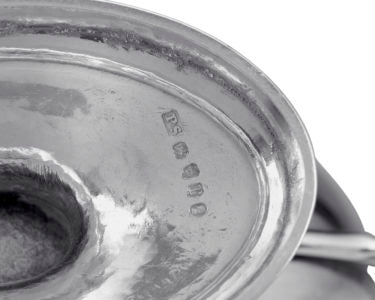Georgian Silver
The Georgian Era is a period of British history from 1714-1830 as marked by the reigns of George I, George II, George III, and George IV, the first four Hanoverian kings of Great Britain. The era saw a remarkable increase in innovation, the expansion of the British Empire, and a flowering of the arts, both literary and visual.
Due to the Georgian era's 116-year span and ever evolving decorative styles, it is more accurate to consider both the Early Georgian and Late Georgian periods. In regards to silver, during the Early Georgian period (1714-1760), Queen Anne style reigned supreme, marked by simple, elegant forms and minimal decoration. However, around 1725, elements of the exuberant Baroque and Rococo styles began to appear. By the Late Georgian period (1760-1811), a Neoclassical esthetic prevailed, which harkens back to the classical forms of antiquity, particularly the art and architecture of Ancient Greece and Rome. These pieces illustrate classic antique silverware markings that are highly prized today.
The Importance of Hallmarks on Georgian Silver
For centuries, hallmarks have been used in Great Britain to date and grade silver. Perhaps most importantly, this practice of antique silverware markings became a uniform way to guarantee the purity of the material, ensuring that all pieces of sterling equaled 92.5% silver. The five types of silver markings which may be present on English sterling silver include: a maker's mark, assay office or town mark, date mark, assay mark, and duty mark.
Silver markings denotes the silversmith or manufacturer. Typically, the maker's mark consists of the maker's initials.

Maker's Mark
The assay office or town mark indicates the location where the silver was assayed or tested to ensure that it met British silver standards (92.5% pure silver).

Assay Office or Town Mark
The date mark on the antique silver records the year that the piece was assayed. This purity mark on a silver piece consists of a letter of the alphabet, usually in alphabetical order, which was assigned to the year. One must pay special attention to this important mark because letters were reused in capital and lowercase form.

Date Mark
The assay mark on a silver object, sometimes called the "Lion Passant," denotes that the item met the stringent sterling silver standard.

Assay Mark
And finally, the duty mark depicts the reigning sovereign's head and certifies that taxes were paid on the piece. This special silver tax was implemented by George III in 1784 to help pay for the American War of Independence. This mark appears only on antique silver pieces from 1784-1890.

Duty Mark
Major Makers of Georgian Silver
Of all the English silversmiths working during the 18th and early 19th centuries, three remarkable artisans rise above the rest: Paul de Lamerie, Hester Bateman, and Paul Storr.
Paul de Lamerie (1688 - 1751), a Dutch-born silversmith working in England, is considered one of the finest craftsmen in history. De Lamerie first registered his own silver mark in 1712 after serving as an apprentice to London goldsmith Pierre Patel. The early works of de Lamerie are simplistic Queen Anne style vessels; however, by the 1730's he was producing works in the highly ornamental Rococo style. Heralded for his incredible technical skill and innovative designs, de Lamerie was one of the first artisans to incorporate French Rococo design elements into English silver.
Dubbed “The Queen of Georgian Silversmiths,” Hester Bateman (1704 – 1794) is the most celebrated female silversmith in history. Surprisingly, it seems that the talented Bateman began her career as a silversmith by accident. Widowed at the age of 51, Bateman inherited her husband’s tools and registered her mark with the Goldsmith’s Hall in 1761. For the next 30 years and with the help of several family members, she ran a highly successful silver business. Bateman’s designs are minimalistic, marked by elegant form and clean lines as opposed to the then-popular Rococo style. The two signatures of Bateman’s refined aesthetic are beaded edges and bright-cut engraving.
Perhaps the most renowned of all English silversmiths is Paul Storr (1771-1844), who produced work both during the Georgian and early Regency periods. Early in his career, Storr’s designs were Neoclassical in style; however, upon entering a contract with Rundell & Bridge, the Royal Goldsmiths, in 1800, Storr adapted his aesthetic to the elaborate, bold forms preferred by the wealthy patrons of the high-end retailer. Over the next decade, Storr’s silverware developed an international reputation for excellence. In 1811 Storr left Rundell & Bridge, but after only three years of independence, he joined forces with retailer John Mortimer to form the firm Storr & Mortimer. This partnership endured until Storr’s retirement in 1838. Storr’s impeccable designs and unfailing attention to detail led to great success during his own lifetime, even becoming a favorite of King George III, and continue to amaze collectors today.
This blog post is the second of a three-part series which explores the flowering of the arts during the Georgian Era (1714-1830) and serves as a supplement to “House of Hanover: The Georgian Collection” currently on display at M.S. Rau Antiques.







